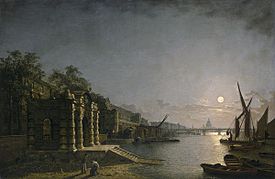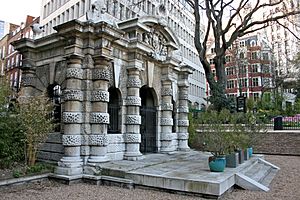York House, Strand facts for kids
York House (formerly Norwich Place or Norwich Palace) was one of a string of mansion houses which formerly stood on the Strand, the principal route from the City of London to the Palace of Westminster.
Building
Norwich Palace
It was built as the London townhouse of the Bishops of Norwich not later than 1237, and on 4 February 1536 it was given by King Henry VIII to his favourite Charles Brandon, 1st Duke of Suffolk in exchange for Suffolk House in Southwark, the Bishop having been provided with a new residence in Cannon Row, Westminster.
York House
It came to be known as York House when it was granted to the Archbishop of York in 1556 and retained that name for the rest of its existence. Its neighbours were on the west Suffolk House (later Northumberland House), the townhouse of the Earls of Suffolk, a branch of the Howard family headed by the Dukes of Norfolk, and in the 1640s sold to the Earl of Northumberland; and on the east Durham House, the London residence of the Bishop of Durham. The Bishop of York was by tradition Lord Keeper of the Great Seal of England and for about seventy years from 1558 the house was leased to various secular holders of that high office, including Nicholas Bacon, Thomas Egerton and Francis Bacon. In the 1620s it was acquired by the royal favourite George Villiers, 1st Duke of Buckingham, and after an interlude during the English Civil War it was returned to George Villiers, 2nd Duke of Buckingham, who sold it to developers for £30,000 in 1672. He made it a condition of the sale that his name and full title should be commemorated by George Street, Villiers Street, Duke Street, Of Alley, and Buckingham Street. Some of these street names are extant, though Of Alley has been renamed York Place, Duke Street is now John Adam Street and George Street is now York Buildings. Villiers Street runs along the eastern side of Charing Cross railway station.
Riverside setting
The mansions facing in the Strand were built there partly because they had direct access from their rear gardens to the River Thames, then a much-used transport artery. The surviving York Watergate (also known as Buckingham Watergate), built by George Villiers, 1st Duke of Buckingham in about 1626 as a ceremonial landing stage on the river, is now marooned 150 yards (137 m) from the river, within the Embankment Gardens, due to substantial riverside land reclamation following the construction of the Thames Embankment. With the Banqueting House it is one of the few surviving reminders in London of the Italianate court style of King Charles I. Its rusticated design in a Serlian manner has been attributed to Sir Balthazar Gerbier, to Inigo Jones himself and to the sculptor and master-mason Nicholas Stone. The design is modelled closely on that of the Medici Fountain in the Jardin du Luxembourg in Paris. It was restored in the 1950s.
Events

The York House Conference which assembled there in February 1626 ended unsatisfactorily with the final rupture between Puritan members of Parliament and Buckingham. York House was the setting for a masque presented before their majesties in May 1627, in which Buckingham appeared followed by "Envy, with divers open-mouthed dogs' heads representing the people’s barking, while next came Fame and Truth", just before his departure for his unsuccessful second foray against France.
The first Duke granted lodgings at York House to the painter Orazio Gentileschi, and to Sir Balthazar Gerbier, diplomat and sometime painter. Although the Duchess tried to expel the latter after the Duke's assassination in 1628, it was in Gerbier's lodgings that Peter Paul Rubens sojourned during his visit to London the following year.
Inventory
An inventory of the contents of York House drawn up in 1635 is a valuable source for scholars both for the light it sheds on one of the handful of great art collections formed in the circle of Charles I, and for the furnishings of a fashionable early Stuart nobleman's residence. In the 'Great Chamber' twenty-two paintings were displayed with fifty-nine pieces of Roman sculpture, many of which were heads. In the 'Gallery' were a further thirty-one heads and statues. Apparently the only modern sculpture at York House was Giambologna's Samson and a Philistine, a royal gift from King Philip IV of Spain to Charles I, who passed it to his favourite, Buckingham.
Legacy
In the early 19th century the designation York House was revived by the palatial York House, built in the Stable Yard, St. James's Palace, for the Duke of York, brother of George IV and heir apparent. Foundations were begun to designs by Robert Smirke, who was quickly replaced by Benjamin Dean Wyatt and his brother Philip; when the Duke died in 1827, deeply in debt with the house unfinished, it was subsequently completed as Stafford House; its gilded interiors by Sir Charles Barry for Stafford's heir, the Duke of Sutherland, inspired Queen Victoria's famous remark about "coming from my house to your palace".
The name is carried today by a commercial building in Portugal Street, Kingsway, London.
The York Watergate is at the centre of the song "London Plane" by progressive rock band Big Big Train on their 2016 album Folklore. The song is written from the perspective of a nearby London plane tree that was a sapling at the time of the construction of the Watergate in 1626 and tells of the stories that such a tree may have witnessed in the years since.



